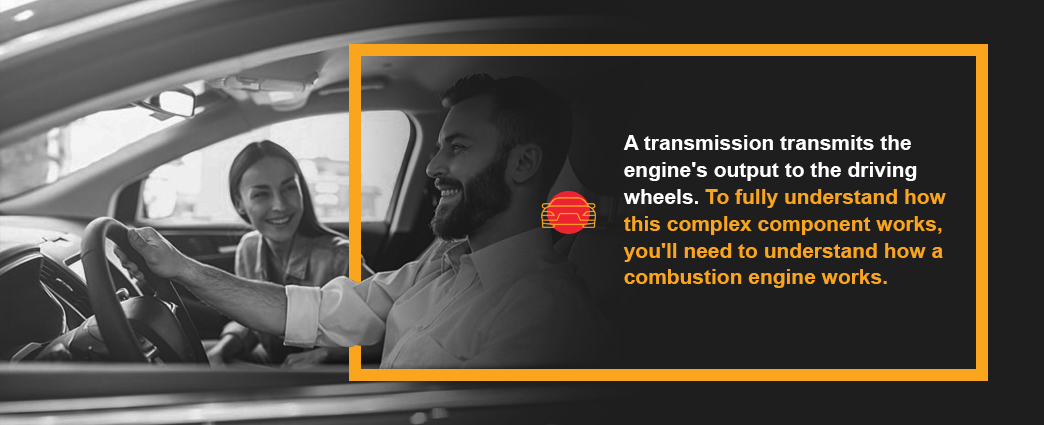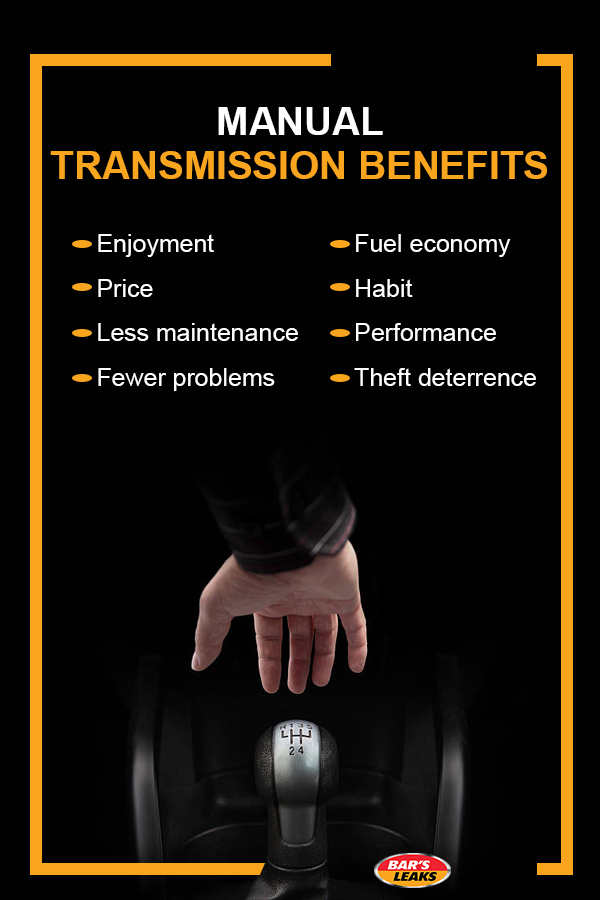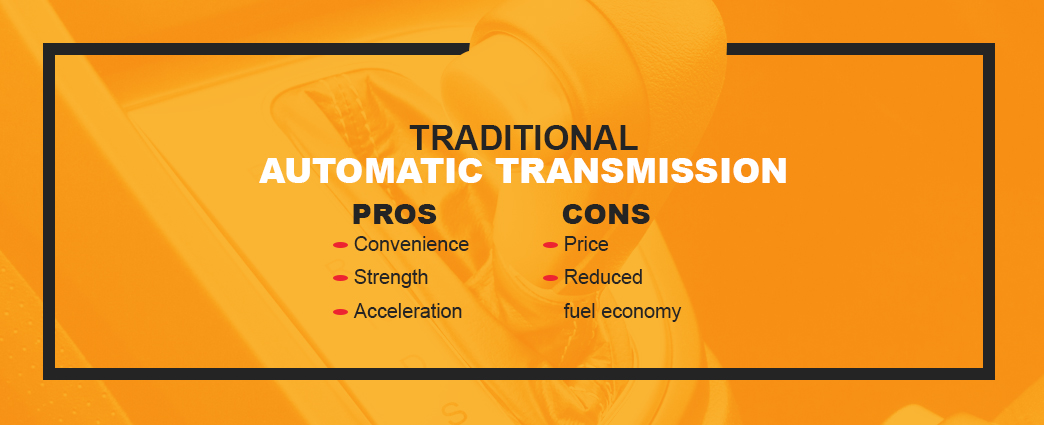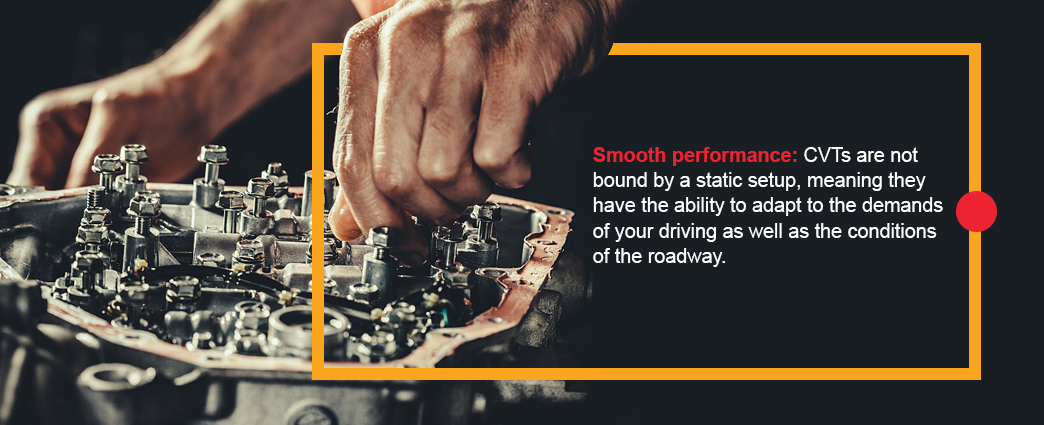Continuously Variable Transmission Manual or Automatic
Cars on the market today feature a variety of transmission types, ranging from old-school manual to automatic to continuously variable transmissions (CVT). In this article, we will explain how each transmission type works and discuss the pros and cons of each.

What Is a Transmission?
Simply put, a transmission transmits the engine's output to the driving wheels. To fully understand how this complex component works, however, you'll first need to understand how a combustion engine works: In the cylinders of the engine, a fuel-air mixture is ignited, which causes the pistons to start moving up and down. The motion of the pistons, in turn, is used to spin the crankshaft of the car. When you press on the gas, there is more fuel in the cylinders to burn, which causes the entire process to move faster and faster.

So what role does the transmission play in this process? It is in charge of changing the ratio between how quickly the engine's spinning and how quickly the driving wheels are moving. When the car is in a lower gear, that means it will perform optimally when the wheels are moving more slowly than the engine, and when it's in a higher gear, it means the car will perform optimally when the wheels are moving faster than the engine.
There are two basic transmission types in cars — automatic and manual. Both of these transmission types channel the power that is generated by the engine to the drive wheels. The notable exception is a continuously variable transmission (CVT), which is also known as a gearbox. A CVT is a metal case that's filled with oil and contains gears, bearings, shafts and various other components. Each gear has a certain ratio to make sure that the wheels spin at the same speed as the engine. Mountain bikes feature a simpler version of this technology.
The way a transmission works is actually quite simple on paper. Torque from your engine goes into the transmission via the input shaft, goes through the gears and then comes out the output shaft. How it gets to the wheels from there will depend on whether the vehicle has front-, rear- or all-wheel drive and whether it's front-, mid- or rear-engined.
Below we'll explain the differences between three common transmissions types — manual, automatic and CVT.
1. Manual Transmission
With a manual transmission, which is also known as a "stick shift," the driver controls gear shifting with a gear stick. Whereas older models often have dash- or steering column-mounted shifters, most cars today have them mounted vertically on the center console.

A manual transmission's various gears allow the vehicle to travel at varying speeds. Gears that are large offer lots of torque but lower speeds, whereas smaller gears deliver less torque but let the vehicle travel faster. Manual transmission cars in the 40s, 50s and 60s, including the original Ford Mustang, came with three speeds. As technology improved, automakers added more gears. Four-speed manual cars then became standard, then five and now six. However, certain high-end manual sports cars have up to seven gears.
Another key feature of manual transmissions is the clutch disc, which is sandwiched between the transmission and the engine. To switch gears, the driver must release this clutch disc using another pedal, which is located to the left of the brake. You must release the clutch, pick the gear you want and then re-engage the clutch. From a standstill, if you engage the clutch too slowly, you'll wear the disc out prematurely, and if you engage it too fast, the engine will stall.
Learning how to drive a car with a manual transmission can take some time, but most people find it a rewarding experience. When driving a stick shift, many people feel a connection with the vehicle that is hard to reproduce with automatic transmission cars. Manual cars also tend to be less expensive than automatics. It is for reasons like these that manual transmissions are still found in many new cars today.
2. Automatic Transmission
There are two basic kinds of automatic transmissions:
- Traditional automatic: This type of automatic transmission is connected to the car's engine via a torque converter.
- Dual-clutch automatic: This automatic transmission type depends on a pair of clutches.
Both of these transmission types can switch gears without the driver's input. The vehicle determines when to change gears by monitoring parameters like the speed at which the car is traveling, the position of the throttle pedal and the revolutions of the engine. It then switches gears either hydraulically or electronically. Automatic cars often feature gears that the driver can manually select by either using a shift lever or paddles mounted behind the steering wheel.
Drivers can control a car with an automatic transmission with only two pedals, which offers several benefits. For one, stalling the engine is almost impossible with this configuration, and driving an automatic is usually a smoother experience than driving a stick shift, especially if in stop-and-go traffic. Also, automatics tend to require less maintenance than manuals, although this can vary from one model to the next. Finally, the gearboxes in dual-clutch automatics often shift in just milliseconds, which means improved efficiency and performance.

Although now the most common transmission type in the United States, a transmission that shifts gears automatically was once an expensive luxury. The first automatic transmission cars had four speeds, although today it's common to find automatics with six, seven or more speeds. You can even find vehicles with nine and ten speeds on the market. The more gears a car has, the better the acceleration, the quieter the highway driving and the better the fuel economy.
3. Continuously Variable Transmission
Adding gears to the transmission of a car facilitates optimized performance across a wide range of conditions, which is why some new cars with automatic transmissions feature gear ratios in the double digits.
CVTs take this idea to the next level by providing an infinite number of gear ratios. This, in theory, leads to optimal performance in any driving situation. Of course, individual results may vary in the real world.
CVTs achieve this by relying on a belt and pulley system instead of physical gears. One pulley gets turned by the car engine, and the other connects the driving wheels with the transmission. The pulleys' diameter is adjusted to alter the power-distribution ratio.
To better understand this configuration, visualize the inside the pulley as two cones facing one another with a V-shaped belt in the valley above the two points. When the transmission moves the two cones closer together, it pushes the belt up and out, as if it had placed the belt around a bigger gear. But rather than move from one physical gear to the next in distinct shifts, the belt smoothly slides over the two cones and can operate at any diameter.
This setup lets an engine stay in its sweet spot no matter what speed the car is going. As you may have guessed, driving a CVT-equipped car is quite different from driving a traditional automatic. They're generally smoother to drive than equivalent models equipped with regular automatic transmissions. CVTs can also boost gas mileage, and many hybrid cars are equipped with them for this reason. However, CVTs do come with drawbacks for some drivers — some find it strange that they don't shift. The engine often makes a droning noise when bolted to a CVT, and vehicles will often deliver a rubber band-like acceleration.
To help make CVTs more appealing to drivers who aren't used to them, some car companies offer CVT-equipped cars with shift paddles, which select preprogrammed ratios to imitate the gears found in a traditional automatic. As not everyone loves driving CVTs, it's recommended that you take one for a test drive before you purchase.
CVTs are found in a countless number of cars in Japan, and they're becoming more and more popular in the US. The Honda CR-V and Subaru Crosstrek are examples of models equipped with a CVT transmission. CVTs are also common in motorcycles, snowmobiles and scooters.

Manual Transmission Pros and Cons
Manual transmission vehicles have several advantages that that many people may not be aware of, which is perhaps why most cars sold in the US today are automatic. However, when you buy a product based on convenience, it's often at the cost of other benefits. In the case of manual cars, these benefits include:
- Enjoyment: People who buy manuals often love driving their vehicles.
- Price: Manual transmissions are generally less expensive than their automatic equivalents. This is because manual transmissions have fewer moving parts and are less in demand.
- Less maintenance: Manual transmissions have fewer moving parts and are simpler than automatics. This means that routine maintenance is also easier and cheaper. Servicing a manual transmission often involves no more than an oil change, and manuals require service less frequently than automatics.
- Fewer problems: Due to their more complex nature, automatic transmissions develop many more problems than manuals, and repair costs for automatics are significantly higher. The most common repair for manual transmission vehicles is a clutch replacement, which usually isn't even necessary for hundreds of thousands of miles.
- Fuel economy: Although some automatic transmission models are sophisticated enough to rival manuals in fuel efficiency, a manual transmission — when driven properly — usually performs better than an automatic. This is mostly due to the reduced loss of power and the ability for drivers to optimize their driving for better gas mileage.
- Habit: In many cases, people who have been driving a stick shift since they first learned how to drive are still driving one.
- Control: If you ask a manual driver what's the one aspect of stick shifts that they enjoy most, they'll often say "control." Being involved in the performance of their car brings many stick drivers joy and makes them want to stick with manual transmission vehicles.
- Performance:Manual transmission cars tend to accelerate better, weigh less and lose less power than equivalent cars equipped with automatic transmissions. For drivers who enjoy performance cars, a manual transmission is often the obvious choice.
- Theft deterrence: It's not something most buyers think about, but manual transmissions can also be an effective theft deterrent. As most drivers in North American can't drive stick, this effectively lowers the chance of someone stealing your vehicle.

Manual transmissions are also associated with the following drawbacks:
- Complexity and direct involvement: Driving a manual requires work and involvement, meaning that you must focus on things like correct pedal movements, cycling from clutch to gas to brake, etc. For some drivers, driving a manual may be more of a chore than a joy. If you're someone who values relaxation and comfort more than speed and performance, then a manual may not be the best choice for you.
- Lower resale value:Manual cars tend to have lower resale values. This is due to the decreasing popularity of manuals in the United States.
Traditional Automatic Transmission Pros and Cons
Although not as popular in most other countries, most of the cars sold in the United States since the 1950s have had automatic transmissions. Although automatics first became popular for the convenience they offer, automatic vehicles have also shown themselves to be efficient, capable performers.
Some benefits offered by automatic transmissions include:
- Convenience: The primary benefit of automatic transmission vehicles is that they're easy to drive.
- Strength:Automatic transmissions have more power than any equivalent vehicle with a manual transmission. Traditional automatics rely on a planetary gear set housed close to the back of the transmission. This gear set uses a set of tiny "planet" gears that are driven by a "sun in the center and a "ring" gear on the outside, which transfers power. This configuration increases the surface contact between gears, spreading the torque load over a large area and reducing breakage.
- Acceleration: Automatics generally shift faster and with more accuracy than most stick drivers can manage. Shifting gears in a manual requires several degrees of driver movement, which creates opportunities for mistakes. On most automatic transmissions, the distance between engagement clutches is just a few nanometers, meaning that an automatic could, in theory, shift more quickly than you can blink.
Some drawbacks associated with traditional automatic vehicles include:
- Price:Not only do automatic transmission vehicles cost more upfront, but they cost more over their lifetime. Repairs costs for automatics tend to be higher because automatics are much more technical and complex.
- Reduced fuel economy: In addition to their high price, automatics also offer a less competitive fuel economy. This is due to the heavier weight of the transmission and torque converter. The heavier a car is, the more power is required to move it, and the more fuel it will need to consume.

CVT Transmission Pros and Cons
Advantages of the CVT transmission include:
- Fuel efficiency: Unlike traditional automatic transmissions, CVTs can always alter the gear ratio to keep your engine running at maximum efficiency. Generally speaking, the more gears available in a traditional automatic transmission, the better the engine power is optimized. Whereas as even the most advanced conventional transmissions have no more than ten gears, CVTs have an infinite number of gears, leading to better gas mileage. It is for this reason that they often appear in hybrid cars.
- Less weight: Although not always the case, CVT transmissions generally weigh less and take up less space than traditional automatic transmissions.
- Simpler, less expensive design: Traditional automatic transmissions are complicated and often contain hundreds of components. CVTs, on the other hand, have a considerably simpler design, meaning they easier to assemble and require fewer resources to produce. This explains their lower cost.
- Smooth performance: CVTs are not bound by a static setup, meaning they have the ability to adapt to the demands of your driving as well as the conditions of the roadway. CVTs never have to "hunt for gears" because the computer system onboard always stays in the spot that maximizes power and effectiveness. No matter what the circumstance is, driving a CVT is always constant and smooth because it doesn't "shift" like traditional automatics.

CVTs are not without their disadvantages, however. These drawbacks include:
- Not yet designed for power: CVTs are currently being built to maximize gas efficiency, which explains why they're commonly used on hybrid vehicles.
- Different feel: If you're an older driver who's been driving for many years, the CVT will feel unusual to drive. One of the most noticeable differences is that the throttle action will feel a bit postponed. Depending on the scenario, CVT-equipped vehicles can stay in the higher RPM range without undue wear and tear to the engine, which is not the case with non-CVT transmissions.
- Higher routine maintenance bills: CVTs are still a relatively new technology and certified CVT professionals are not as common as conventional automatic transmission technicians. The small number of accredited CVT technicians may lead some independent stores to charge more. Don't forget to ask your service consultant for an individualized quote for the transmission of your vehicle.
How Long Do CVT Transmissions Last?
CVT units do not last as long as traditional automatic transmissions, with most lasting 100,000 or less. However, keep in mind that CVT technology is still relatively new and is constantly improving.
Because of the relative newness of CVTs, many owners of CVT-equipped cars are not familiar with how to properly maintain them. CVTs have a delicate and strict maintenance schedule that customers must be aware of and stick to. If you treat your CVT like a conventional automatic transmission, it could lead to reliability issues down the road, which could make your transmission more expensive to fix than a traditional automatic. Proper maintenance will go a long way to prolong the life of your CVT transmission.

Use Bar's Leaks Products to Avoid Expensive Repairs
At Bar's Leaks, it is our mission to make car maintenance and repair as simple as possible for our customers. If you're able to open your car's hood and open a bottle, you'll be able to maintain your car using Bar's Leaks products. For decades, our products have been turning our customers into "three-minute mechanics" for a wide variety of vehicles and leaks. Save yourself a costly trip to the mechanic by using Bar's Leak products, which are specially formulated to seal the issue from within so you can return to your busy life — all while avoiding expensive repair bills. Visit our page to find a store near you.

Source: https://barsleaks.com/transmission-2/automatic-vs-cvt-vs-manual-transmission/
Post a Comment for "Continuously Variable Transmission Manual or Automatic"